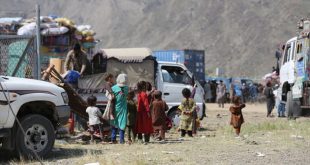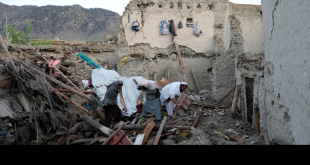‘400km square lands newly contaminated with landmines, unexploded devices’
By Farhad Naibkhel-KABUL: Despite spending of millions of dollars in mine clearance program in the past decades still mine blast and unexploded ammunitions deemed as big challenge in Afghanistan, as averagely 142 people being killed or sustained injuries by mine and unexploded munitions monthly across the country. Without doubt, landmines and other unexploded objects continue to jeopardize the security of Afghan masses. The country is still littered with hazardous explosive devises, meaning that even in areas where conflict has ceased, civilian risk being killed or injured by weapons of war.
This weapon (landmines) can truly be called evil. They are known as hidden killers, weapons of mass destruction in slow motion, or the perfect soldier which never sleeps or misses. In Afghanistan mostly civilian with high percentage of women and children were main victim of this hidden killer.
“Based on records, averagely 142 people are being killed or sustained injures due to landmine and unexploded devices monthly in 2016,” State Minister for Disaster Management and Humanitarian Affairs, Wais Barmak told newsmen on Monday.
Addressing a ceremony titled, international day of mine awareness and assistance in mine action, he said, “since 2001 mine casualties had a decline shape, but after 2011 mine and unexploded casualties have been increased in the country.
“Mounting of war and contamination of lands by IEDs and mines by the Taliban insurgents and other anti-government insurgents is the main factor behind increasing of mine victims nationwide,” he added.
He further went on saying that, “400km square lands have been tainted newly to landmines, IEDs and unexploded ammunitions by anti-government insurgents in 17 provinces.”
Currently 1000km square lands existed with landmines, IEDs and unexploded devices, he noted.
He also informed of five years strategic plan to clear landmines.
Complaining about decrease of funds for demining programs, he said “last year we need over $80 million for demining programs, but only earned $35 million, which show a reduction by over 50 percent.”
He called over all donors to support demining programs in Afghanistan in order to safeguard civilians form this deadly menace.
He elaborated that 14000 de-miners were working across the country, but nearly 5,000 of them have been fired due to lack of budget.
“Lack of awareness was one of the main factors for high casualties of children and women by mine explosion, the relevant organs have to arrange awareness campaign for all people in general but for children in particular in the areas with landmine,” he mentioned.
According to report when the Russian invaders left Afghanistan in 1988, mine casualties was 20-25 people daily, but through hard working the mine clearance organizations succeeded to reduce these casualties to 1-2 persons daily. Casualties of mine and unexploded ammunition increase back since 2011 across the country.
Some 70 percent of Afghanistan was cleaned from landmine risk in the past two decades by the ATC in cooperation with the other demining organizations, but still 30 percent of the areas existed with mine, which included agriculture lands, deserts and mountains.
Deploying landmines was propagated during Soviet Union invasion, which after leaving of Soviet Union mines was used by some rings during civil war to target dissident groups that was caused to casualties of tense of people on daily basis across the country. According to unconfirmed report, 50 million landmines were deployed in Afghanistan. Some 700,000 have been killed through landmine and unexploded immunizations in the past three decades in the country.
Based on report, UN has estimated that 100 million mines, or more, may be deployed in 62 nations. That’s one mine in the ground for every 50 humans on earth. The vast majority of landmines in use today have no means of self-neutralization or self-destruction. Disarming them all would cost from $20 to $30 billion. It is also anticipated that there are also an additional 100 million mines in stockpiles around the world.
 Afghanistan Times
Afghanistan Times



